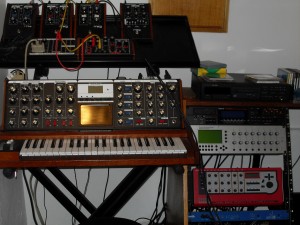For audio see below
The Strange Mechanism is the name of my electronic music studio. It comes from the work of ethnomusicologist Gilbert Rouget and is used to designate the role of music in triggering trance states. It seemed to suit, given the way my music seemed to displace any sense of time I had in the studio (usually recording late into the night); and also given the very complex modular synthesis at work in these real-time interactive compositions.
My intention with these works was to design an electronic system capable of generating music that is constantly evolving. I was influenced in this, by my reading of Pauline Oliveros and Steve Reich. I embraced Cage’s ideas on indeterminate composition and his insistence on the musical value of noise and silence; Xenakis’ development of algorithmic composition; and in particular Stockhausen’s ideas in ‘The Concept of Unity in Electronic Music’:
the correlation of the coloristic, harmonic-melodic, and metric-rhythmic aspects of composition
the composition and de-composition of timbres
the characteristic differentiation among degrees of intensity
the ordered relationships between sound and noise
I designed electronic systems which would generate music that constantly evolved into noise and vice versa, deliberately playing on the music:noise dichotomy. The music was composed in real-time with the shaping of the musical timbres generated by Clavia Nord Modular Analog Synthesizer using filters, phaser, delay, reverberation and mixing console. Given the fact that the Nord Modular is four-part multi-timbral, I was able to work with four electronic systems simultaneously (some of which were also polyphonic). There was no multi-tracking, over-dubbing or post-production in the making of these works.
Select Titles Below to Access Audio
Sonography
Control Signal
Signal to Noise
Uncertainty Principle
Total Harmonic Distortion
Frequency Response
Critical Bands
